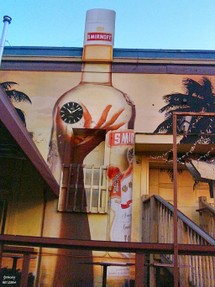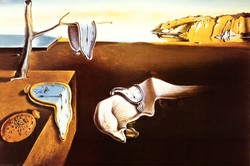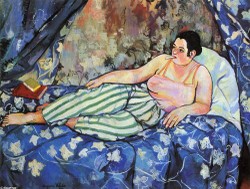What was Salvador Dali trying to achieve in the surrealist painting "The Persistence of Memory"? The concepts about time he attempted to capture still perplex scientists to this day. The illusionary nature of time was a theme that Dali explored over a 15year period. Like other painters of this era, Dali tried to come to terms with post war society by painting in a cathartic manner. The dreamlike atmosphere of the bent and twisted objets d'art are loaded with poignant symbolism.

Understanding The Persistence of Memory by Salvador Dali
by Jo_Murphy
Dali's work was prophetic. Scientists still struggle to explain the concepts of time that the talented artist valiantly portrayed.
The Relationship Between Memory and Time
Dali Grapples with Complicated Scientific Concepts
One of the most important Surrealist paintings, The Persistence of Memory has been in the collection of the Museum of Modern Art (MoMA) in New York City since 1934. The painting by Salvador Dali depicts time as a melted, morphed pocket watch. This illusion captures Dalí's theory of "softness" and "hardness", which grapples with the ineffable illusory slipperiness of our human perception of time. It also alludes to the tenuous grasp we all have on the way we deal with time. Dawn Ades wrote, "The soft watches are an unconscious symbol of the relativity of space and time, a Surrealist meditation on the collapse of our notions of a fixed cosmic order".
The Persistence of Memory was a prophetic painting. Even now, we as human beings have a hard time understanding the elastic nature of time. Scientists have certainly been trying to explain inconsistencies characteristic of time. Authors such as George Smoot, Stephen Hawking and Michio Kaku do a good job of explaining this difficult
phenomenon, but it is still a hard concept for most people to comprehend.
 | Surrealism: Desire UnboundPrinceton University Press |
 | Music Of Surrealism: Desire Unbound |
Were Surrealists Joking or Were They Deadly Serious?
Horror in the Aftermath of War
Dalí told Ilya Prigogine that the soft watches were actually a representation of a “Camembert cheese melting in the sun”. But this seems to have been a joke of some kind. (Many of the Surrealist paintings were sardonic jokes of some kind) The prolific artist then proceeded to turn the attention of his work to exploring time in a systematic way.
Dalí is reported to have gone through a Freudian phase, but this later transitioned to a scientific phase, which stretched for fourteen years. It is thought that Dali’s thinking was influenced by the atomic bombings of Hiroshima and Nagasaki in 1945.
Dalí’s paintings often manifested as self-portraits and his symbolism was often repeated. In the case of The Persistence of Memory, Dali painted ants to symbolize decay. We can only imagine that this would have been the perceived decay of society that other artists such as Abstract Expressionists also reacted to.
There is quite a lot of imagery in the painting that pertains to dreamlike states and dreaming. The truth is that we are not exactly sure what the different parts of the painting symbolize. We can take a guess that the clocks, as well as the name of the painting indicate that the imagery is about the different way(s) that times passes. It is difficult for human beings to grasp whether time is a construct of their own imagination or whether time exists whether or not people are there to count, quantify and measure its passing. And the way memory is processed as a cascade of kaleidoscopic formings when people are dreaming.
Scientific Resources
Scientists are Catching up with Artist's Premonitions
 | Wrinkles in Time: Witness to the Birth of the Universe Astrophysicist George Smoot spent decades pursuing the origin of the cosmos, "the holy grail of science," a relentless hunt that led him from the rain forests of Brazil to the f... |
Sardonic Humor and Irony
Dali an Artist Well Ahead of His Time
Dali had the capacity to painting in a very realistic manner, but he employed these realistic techniques to juxtapose elements in unlikely ways. The unusualness of the compositions had an impact of creating dreamlike atmospheres. The paintings beg the question “What Is Time?’ Even to this day scientists have a difficult time explaining the answers to this question in a satisfactory way. The book Wrinkles in Time suggest that time itself can change and morph in nature. An interesting aspect of the painting is that time is represented as taking place in a backdrop or within a landscape. In this case, the “landscape” is a mentalist environment for dreams to take place within.
It is said that the rocks of the landscape portray the tip of Cap de Creus peninsula in north-eastern Catalonia.
It is interesting to note that Dalí often painted around the theme of time and the persistence (and distortion?) of memory. By linking time with dreaming, Dali has been able to capture the disorderly functions of time, and the way dreams can combine aspects of “reality” in manners that are not linear. He has predicted modern theories that posit time can shrink and stretch.
(Is time a thing?? If it can stretch, can it melt?)
Some of his other works on this topic are
- The Disintegration of the Persistence of Memory (1954); a work is now in the Dalí Museum in St. Petersburg, Florida.
- The Nobility of Time,
- The Profile of Time
- The Three Dancing Watches.
This Book is a Must for People Trying to Understand Time
Stephen Hawking
 | A Brief History of Time #1 NEW YORK TIMES BESTSELLERA landmark volume in science writing by one of the great minds of our time, Stephen Hawking’s book explores such profound questions as: How did the u... |
Time as a Commodity
Added after discussion with other writers
I have added this little idea to this article after discussing the notion of time with other writers. A while back, I wrote an article on Suite101 called Time as a Commodity The articles talks about multi-media art and the way modern society has fallen into the trap of splicing and dicing time. This process started with the clock. Minutes, hours, days ....years...ages ... and then once divided up into packages time itself was something that could be bought and sold. (Think of slaves)

Zygmunt Bauman has dveloped the idea of Liquid Modernity over a period of time. It is a simple idea. In a global world human beings are not as grounded in stable society as they once were.(Bauman 2000)
Last night I was writing a FRASB and found a picture of a huge bottle and so I reworked it to represent Time in a Bottle. Time as a thing that we can buy and sell.
Enjoy!
Pour me another glass of time would you?
Other Relevant Articles
Creative Arts
You might also like
Suzanne Valadon - "The Blue Chamber"Suzanne Valadon was a Fench circus performer, artist's model, waitress and si...
What is the Point of an Artist Painting a SelfiePlaying a significant role in the artworld throughout history, artists' self-...











 As We Age - We React to Life's Challenges Differentlyon 03/16/2024
As We Age - We React to Life's Challenges Differentlyon 03/16/2024
 Organic Gardening - Cunnamulla Styleon 03/08/2024
Organic Gardening - Cunnamulla Styleon 03/08/2024
 Cunnamulla - Premium Destination Outbackon 12/17/2023
Cunnamulla - Premium Destination Outbackon 12/17/2023
 OpenAI and Watermarkson 02/06/2024
OpenAI and Watermarkson 02/06/2024



Comments
No - one more thing to add to the holiday entertainment list. I might watch it tonight.
https://www.youtube.com/watch?v=5lQMf...
Youtube just gets better and better.
The hitchcock film Spellbound with Gregory Peck and Ingrid Bergman had Salvador Dali inputs.
Have you seen the film?
Hi Derdiri, I think that when you mention Dali - Persistence is the painting that first comes to mind. It was groundbreaking at the time. I wonder if I am qualified to talk about his last works. They were a bit beyond me at the time I saw them. I might kid my niece and sister to come back with me for another viewing. 2025
Thank you for the link!
Is it known whether Dali had among his creations a least favorite and a most favorite?
New York City listing The persistence of memory among its permanent collection perhaps makes that painting the most beloved, most significant Dali artwork to many Unitedstatesians.
Online sources mention, as the Museum of Modern Art mentions, the source as an "anonymous" donor. Wouldn't it be interesting as to that donor's identity?
We went to visit Dali's House and the museum.
https://www.spain.info/en/destination....
It is massive.
He was quirky. But to be truthful, I think he fell from High art to Pop at the end, due to financial stress. But hey, we all do financial stress. It is interesting to see how another artist survives.
The persistence of memory has its watches, as human constructs, and its landscape, as natural constructs, at different times.
It's difficult here to access Dali writings. But wouldn't it be interesting to see how those times match with numbers -- not necessarily addresses, dates and times -- in the painter's life and perceptions?
Hi Dave, Sorry that I didn't acknowledge this - it mustn't have alerted me.
Art seems to be a two way street. Communication between artists and audience. Jo
Yes He is intriguing! Thanks for stopping in,
Jo
Love Dali's work, especially this piece.
Danish for mother's mother. It's also what they call Cloris Leachman in Raising Hope, I find that show amusingly earthy, and recommend it to all and sundry.